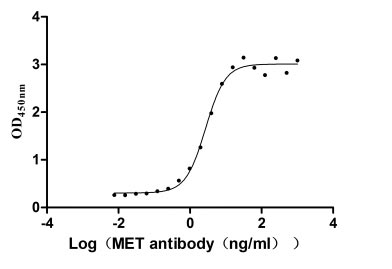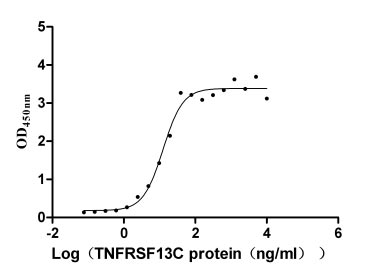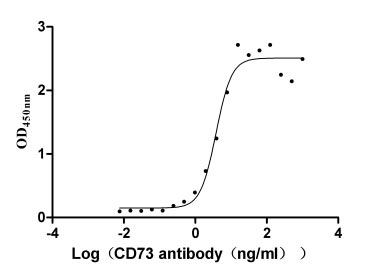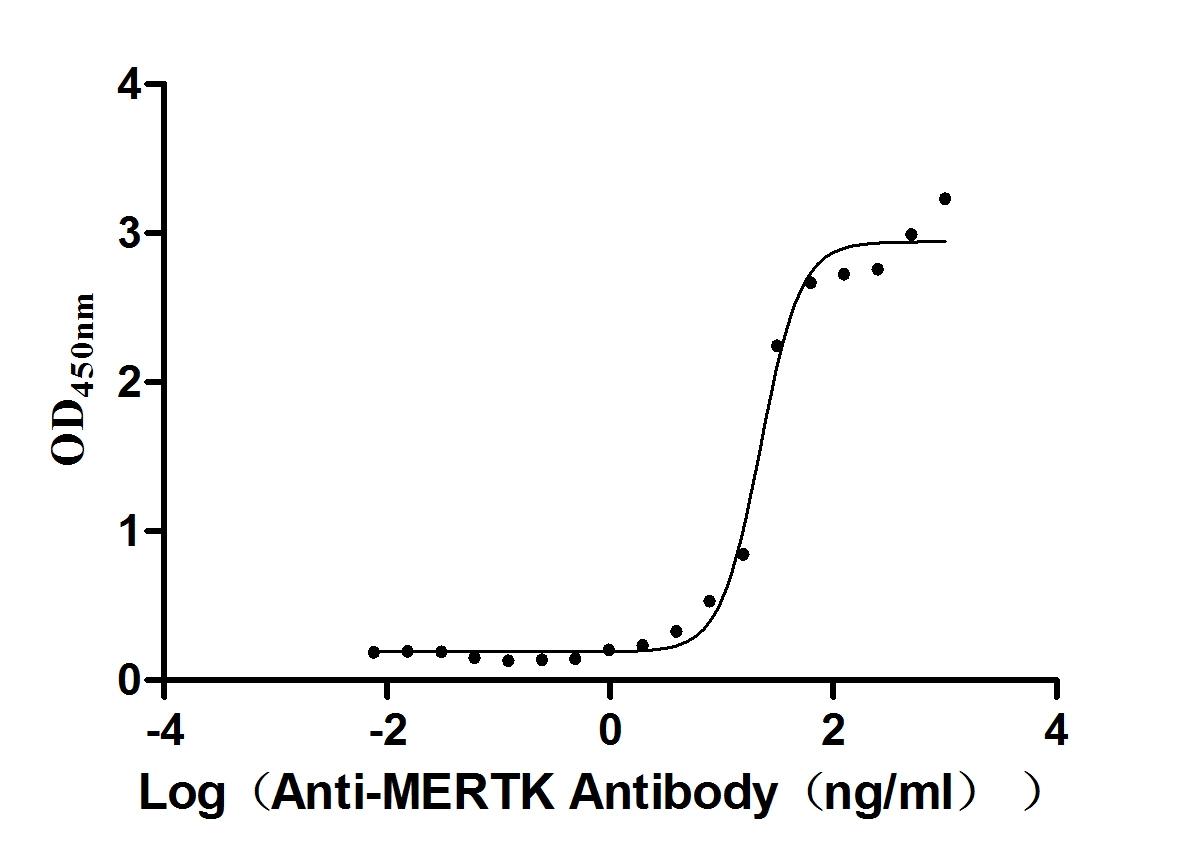Recombinant Human Multidrug and toxin extrusion protein 1 (SLC47A1), partial
-
中文名称:人SLC47A1重组蛋白
-
货号:CSB-YP822212HU
-
规格:
-
来源:Yeast
-
其他:
-
中文名称:人SLC47A1重组蛋白
-
货号:CSB-EP822212HU
-
规格:
-
来源:E.coli
-
其他:
-
中文名称:人SLC47A1重组蛋白
-
货号:CSB-EP822212HU-B
-
规格:
-
来源:E.coli
-
共轭:Avi-tag Biotinylated
E. coli biotin ligase (BirA) is highly specific in covalently attaching biotin to the 15 amino acid AviTag peptide. This recombinant protein was biotinylated in vivo by AviTag-BirA technology, which method is BriA catalyzes amide linkage between the biotin and the specific lysine of the AviTag.
-
其他:
-
中文名称:人SLC47A1重组蛋白
-
货号:CSB-BP822212HU
-
规格:
-
来源:Baculovirus
-
其他:
-
中文名称:人SLC47A1重组蛋白
-
货号:CSB-MP822212HU
-
规格:
-
来源:Mammalian cell
-
其他:
产品详情
-
纯度:>85% (SDS-PAGE)
-
基因名:SLC47A1
-
Uniprot No.:
-
别名:FLJ10847; hMATE-1; hMATE1; MATE-1; MATE1; MGC6482; multidrug and toxin extrusion 1; Multidrug and toxin extrusion protein 1; S47A1_HUMAN; SLC47A1; Solute carrier family 47 member 1
-
种属:Homo sapiens (Human)
-
蛋白长度:Partial
-
蛋白标签:Tag type will be determined during the manufacturing process.
The tag type will be determined during production process. If you have specified tag type, please tell us and we will develop the specified tag preferentially. -
产品提供形式:Lyophilized powder
Note: We will preferentially ship the format that we have in stock, however, if you have any special requirement for the format, please remark your requirement when placing the order, we will prepare according to your demand. -
复溶:We recommend that this vial be briefly centrifuged prior to opening to bring the contents to the bottom. Please reconstitute protein in deionized sterile water to a concentration of 0.1-1.0 mg/mL.We recommend to add 5-50% of glycerol (final concentration) and aliquot for long-term storage at -20℃/-80℃. Our default final concentration of glycerol is 50%. Customers could use it as reference.
-
储存条件:Store at -20°C/-80°C upon receipt, aliquoting is necessary for mutiple use. Avoid repeated freeze-thaw cycles.
-
保质期:The shelf life is related to many factors, storage state, buffer ingredients, storage temperature and the stability of the protein itself.
Generally, the shelf life of liquid form is 6 months at -20°C/-80°C. The shelf life of lyophilized form is 12 months at -20°C/-80°C. -
货期:Delivery time may differ from different purchasing way or location, please kindly consult your local distributors for specific delivery time.Note: All of our proteins are default shipped with normal blue ice packs, if you request to ship with dry ice, please communicate with us in advance and extra fees will be charged.
-
注意事项:Repeated freezing and thawing is not recommended. Store working aliquots at 4°C for up to one week.
-
Datasheet :Please contact us to get it.
靶点详情
-
功能:Solute transporter for tetraethylammonium (TEA), 1-methyl-4-phenylpyridinium (MPP), cimetidine, N-methylnicotinamide (NMN), metformin, creatinine, guanidine, procainamide, topotecan, estrone sulfate, acyclovir, ganciclovir and also the zwitterionic cephalosporin, cephalexin and cephradin. Seems to also play a role in the uptake of oxaliplatin (a new platinum anticancer agent). Able to transport paraquat (PQ or N,N-dimethyl-4-4'-bipiridinium); a widely used herbicid. Responsible for the secretion of cationic drugs across the brush border membranes.
-
基因功能参考文献:
- genetic association studies in population in China: Data confirm that an SNP in an intron of SLC47A1 (rs2289669) is associated with hypoglycemic response to metformin in patients with newly diagnosed type 2 diabetes; differential increases in basal GLP1 plasma levels are also related to this SNP. (SLC47A1 = solute carrier family 47 member 1; GLP1 = glucagon-like peptide-1) PMID: 28321905
- The impact of assay conditions on IC50 determination is negligible, kinetic characteristics differ among used test substrates, and substrate-dependent inhibition exists for MATE1 and MATE2-K, giving valuable insight into the assessment of clinically relevant MATE-mediated drug interactions in vitro. PMID: 27271370
- Pazopanib inhibits OCT2, MATE1 and MATE2-K, which are involved in cisplatin secretion into urine, potentiating cisplatin toxicity. PMID: 27178732
- The 5' CpG island of SLC47A1 acts as an enhancer for SLC47A1, and DNA methylation in the CpG island plays a role in interindividual differences in hepatic SLC47A1 expression. PMID: 29070695
- The combination of ENT1, MATE1 and OCT2 SNPs may serve as a predictive and prognostic marker in metastatic colorectal carcinoma patients treated with TAS-102. PMID: 28992563
- MATE1 is the major transporter for the cellular uptake of imatinib and crucial for the therapeutic success in CML patients. We suggest that the detailed analysis of MATE1 expression levels and mutations could be a predictor for the response to imatinib therapy. PMID: 27635733
- This study did not identify any of these known SLC47A1 coding SNPs in the Xhosa individuals who participated in this study. PMID: 27226103
- substrate identity exerts comparatively little influence on ligand interaction with MATE1. PMID: 27418674
- MATE1 mRNA levels in peripheral blood cells were significantly higher in patients carrying the minor allele of rs2453579, but not rs2252281, compared to those with other genotypes PMID: 27025966
- MATE1 polymorphisms were associated with hematological toxicity in non-small cell lung cancer patients. PMID: 27590272
- MATE1 rs2289669 may be a significant determinant in the renal clearance of metformin in the case of transporter-mediated drug interactions PMID: 26784938
- Disease progression according to RECIST was also more frequent in carriers of at least one polymorphic MATE1 A-allele (44%) as compared with homozygous carriers of the wild-type G-allele (12.5%) (P=0.07). OCT1 and MATE1 were not associated with PFS. PMID: 25753371
- MATE1 sequesters organic cations within an intracellular compartment that has no influence on secretion in renal proximal tubules. PMID: 26538438
- SLC47A1 rs2289669 G>A variants improve the glucose-lowering effect of metformin through slowing its excretion in type 2 diabetes populations. PMID: 26004431
- MRNA levels of multidrug and toxin extrusion protein 1 (MATE1 or SLC47A1, encoded by 1 of the 11 genes) were significantly lower in patients with FILI. PMID: 25862351
- MATE1 is a membrane transporter for quercetin.MATE1 was highly expressed in peroxisomes and the endoplasmic reticulum as well as in plasma membranes in the liver and intestine. PMID: 25241911
- ADMA and L-arginine are substrates of human CAT2A, CAT2B, OCT2 and MATE1. Transport kinetics of CAT2A, CAT2B, and OCT2 indicate a low affinity, high capacity transport, which may be relevant for renal and hepatic elimination of ADMA or L-arginine PMID: 23864433
- The results confirmed that OAT1, OAT3, OCT2, MATE1, and MATE2-K were coexpressed in tubular epithelial cells. PMID: 23630107
- Decreasing expression of OCT3 and MATE1 in human placenta indicates these transporters may play a role in fetal protection preferentially at earlier stages of gestation. PMID: 23303678
- The 808G>T single-nucleotide polymorphism in OCT2 ameliorated cisplatin-induced nephrotoxicity without alteration of disposition, whereas the rs2289669 G>A single-nucleotide polymorphism in MATE1 had no effect on cisplatin toxicity. PMID: 22569819
- Twenty percent of patients with diabetes that are homozygous for A-allele of SLC47A1 had twofold reduction in HbA1c in comparison with the patients carrying G-allele. PMID: 22882994
- Seven polymorphisms in OCT1, OCT2, and MATE1 genes were compared between 53 type 2 diabetes patients with side effects of metformin and 193 metformin users without symptoms of metformin intolerance. PMID: 22735389
- The effect of novel promoter variants in MATE1 ... on the pharmacokinetics and pharmacodynamics of metformin PMID: 23267855
- Twelve transmembrane helices form the functional core of mammalian MATE1 (multidrug and toxin extruder 1) protein. PMID: 22722930
- Homozygous MATE1 variant could be one of the risk factors for metformin-induced lactic acidosis. PMID: 22242910
- The results suggest that agmatine disposition may be influenced by hOCT2 and hMATE1, two transporters critical in the renal elimination of xenobiotic compounds. PMID: 21128598
- 4',6-diamidino-2-phenylindole (DAPI) can be used as a probe substrate for rapid assays of the functionality of the human MATE1 PMID: 20047987
- This study showed that coordinate function of MATE1 with OCT2 likely contributes to the vectorial renal elimination of organic cationic drugs and that altered activity of MATE1 should be considered as a determinant of renal cationic drug elimination. PMID: 20053795
- characterization of MATE1: kinetic analysis of transport of cimetidine and tetraethylammonium; inhibitors; comparison to hMATE2-K and rMATE1 PMID: 20067714
- The purpose of this study was to evaluate the effects of heterozygous MATE variants on the disposition of metformin in mice and humans. PMID: 20016398
- These findings suggested that the loss of transport activities of the MATE1 G64D and MATE2-K G211V variants were due to the alteration of protein expression in cell surface membranes. PMID: 19158817
- interaction between polymorphisms and OCT1 polymorphisms on the glucose lowering effect of metformin PMID: 19898263
- MATE1 appears to be the long searched for polyspecific organic cation exporter that directly transports toxic organic cations into urine and bile. PMID: 16330770
- an oppositely directed H(+) gradient serves as a driving force of tetraethylammonium transport via rMATE1 PMID: 17047166
- The results suggest that hOCT2 and hMATE1 mediate paraquat transport in the kidney. PMID: 17495125
- hMATE1 and hMATE2-K function together as a detoxication system, by mediating the tubular secretion of intracellular ionic compounds across the brush-border membranes of the kidney. PMID: 17509534
- Sp1 functions as basal transcriptional regulator of human and rat MATE1 gene through two GC boxes. May be conserved among species. We have identified rSNP of hMATE1 gene (G-32A) (belonging to Sp1-binding site) that affects promoter activity. PMID: 17855482
- The molecular basis of substrate recognition by MATE1 was investigated via amino acid substitution in the conserved transmembrane regions. PMID: 18305230
- Genetic variants in multidrug and toxic compound extrusion-1, hMATE1, alter transport function. PMID: 19172157
- Guanin/adenine single nucleotide polymorphism is associated with a reduction in A1C level suggesting it role in the pharmacokinetics of metformin in diabetics. PMID: 19228809
- the rate of transcription of MATE1 is regulated by AP-1 and AP-2rep and that a common promoter variant, g.-66T>C may affect the expression level of MATE1 in human kidney, and ultimately result in variation in drug disposition and response. PMID: 19745787
显示更多
收起更多
-
亚细胞定位:Cell membrane; Multi-pass membrane protein. Note=Predominantly localized at the plasma membrane but also found in intracellular organelles.
-
蛋白家族:Multi antimicrobial extrusion (MATE) (TC 2.A.66.1) family
-
组织特异性:Expressed in adrenal gland, and to a lower extent in liver, skeletal muscle and kidney (especially found in luminal membranes of the urinary tubules, bile caniculi and brush border membranes).
-
数据库链接:
HGNC: 25588
OMIM: 609832
KEGG: hsa:55244
STRING: 9606.ENSP00000270570
UniGene: Hs.232054
Most popular with customers
-
Recombinant Human Hepatocyte growth factor receptor (MET), partial (Active)
Express system: Mammalian cell
Species: Homo sapiens (Human)
-
Express system: Mammalian cell
Species: Homo sapiens (Human)
-
Recombinant Human 5'-nucleotidase (NT5E) (Active)
Express system: Mammalian cell
Species: Homo sapiens (Human)
-
Recombinant Human Semaphorin-4D (SEMA4D), partial (Active)
Express system: Mammalian cell
Species: Homo sapiens (Human)
-
Recombinant Mouse Tyrosine-protein kinase Mer (Mertk), partial (Active)
Express system: Mammalian cell
Species: Mus musculus (Mouse)
-
Recombinant Mouse Complement component C1q receptor (Cd93), partial (Active)
Express system: Mammalian cell
Species: Mus musculus (Mouse)
-
Recombinant Human Glucagon-like peptide 1 receptor (GLP1R), partial (Active)
Express system: Mammalian cell
Species: Homo sapiens (Human)
-
Recombinant Human Claudin-3 (CLDN3)-VLPs (Active)
Express system: Mammalian cell
Species: Homo sapiens (Human)




















